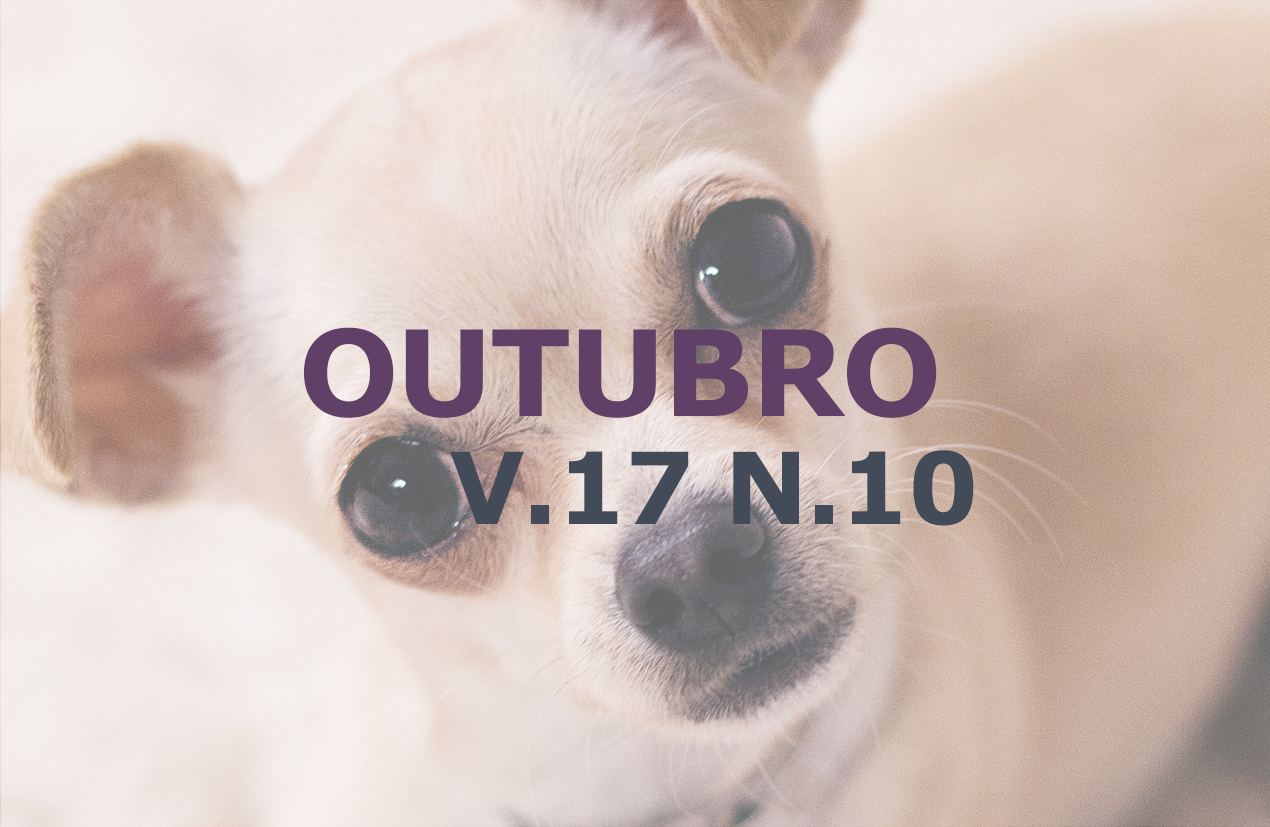Craniotomy for meningioma removal in a dog: Case report
DOI:
https://doi.org/10.31533/pubvet.v17n10e1468Keywords:
anesthesia, dog, postoperative care, meningiomasAbstract
Meningiomas are benign neoplasms that may have a malignant biological character due to intracranial changes, according to your location and cause compression of adjacent tissues. Are among the most common neoplasms of the central nervous system in dogs. They may arise in geriatric patients and cause variable symptoms depending on location, extent and growth rate. Definitive treatment is done by surgical resection and radiotherapy The aim of this study is to report a case of intracranial meningioma involving the left olfactory bulb and frontal lobe in a 10-year-old Shetland Sheepdog, referred to the diagnostic imaging sector through magnetic resonance after presenting seizures generalized and non-ambulatory tetraparesis, as well as the choice of anesthetic and analgesic protocol and postoperative care. It was concluded that patients undergoing craniotomy should undergo general anesthesia with safe protocols that consider the surgical procedure as well as comorbidities, and that the postoperative period of these patients requires follow-up in intensive care units in order to reduce the risk of death and complications.
References
Babicsak, V. R., Zardo, K. M., Santos, D. R., Silva, L. C., Vasconcelos Machado, V. M. & Vulcano, L. C. (2011). Aspectos tomográficos de tumores cerebrais primários em cães e gatos. Veterinária e Zootecnia, 18(4), 531–541.
Caines, D., Sinclair, M., Valverde, A., Dyson, D., Gaitero, L. & Wood, D. (2014). Comparison of isoflurane and propofol for maintenance of anesthesia in dogs with intracranial disease undergoing magnetic resonance imaging. Veterinary Anaesthesia and Analgesia, 41(5), 468–479. https://doi.org/10.1111/vaa.12163.
Carvalho, J. R. G., Carvalho, V. C. H., Bastos, I. P. B., Carvalho, T. F. L., Costa, T. S. & Fernandes, J. I. (2017). Meningioma intracraniano canino: Relato de caso. Brazilian Journal of Veterinary Medicine, 38(Supl. 3), 1–7.
Daleck, C. R., Fonseca, C. S. & Canola, J. C. (2016). Oncologia em cães e gatos. Roca.
Dewey, C. W. (2006). Neurologia de cães e gatos-Guia prático. Editora Roca.
Forward, A. K., Volk, H. A. & Decker, S. (2018). Postoperative survival and early complications after intracranial surgery in dogs. Veterinary Surgery, 47(4), 549–554. https://doi.org/10.1111/vsu.12785.
Fransson, B. A., Bagley, R. S., Gay, J. M., Silver, G. M., Gokhale, S., Sanders, S., Connors, R. L. & Gavin, P. R. (2001). Pneumonia after intracranial surgery in dogs. Veterinary Surgery, 30(5), 432–439. https://doi.org/10.1053/jvet.2001.25867.
Horta, R. S., Martins, B. C., Lavalle, G. E., Costa, M. P. & Araújo, R. B. (2013). Neoplasias intracranianas em pequenos animais-Revisão de literatura. Acta Veterinaria Brasilica, 7(4), 272–281.
Lira, T. L., Oliveira, F. A., Cordova, F. M., Frantz, D. M., Araújo, F. A. P., Souza, P. M. & Passos, A. C. B. T. (2022). Meningioma em cão: Relato de caso. PUBVET, 16(8), 1–6. https://doi.org/10.31533/pubvet.v16n08a1189.1-6.
Marcasso, R. A., Moreira, J. R., Valentim, L. G., Arias, M. V. B. & Bracarense, A. P. F. R. L. (2015). Meningiomas em cães: aspectos clínicos, histopatológicos e imuno-histoquímicos. Pesquisa Veterinária Brasileira, 35, 844–852. https://doi.org/10.1590/s0100-736x2015001000005.
Mariappan, R., Mehta, J., Chui, J., Manninen, P. & Venkatraghavan, L. (2015). Cerebrovascular reactivity to carbon dioxide under anesthesia: a qualitative systematic review. Journal of Neurosurgical Anesthesiology, 27(2), 123–135. https://doi.org/10.1097/ANA.0000000000000092.
Meuten, D. J. (2016). Tumors in domestic animals. John Wiley & Sons.
Niebauer, G. W., Dayrell-Hart, B. L. & Speciale, J. (1991). Evaluation of craniotomy in dogs and cats. Journal of the American Veterinary Medical Association, 198(1), 89–95.
Oliveira, H. E. V., Marcasso, R. A. & Arias, M. V. B. (2016). Doenças cerebrais no cão idoso. Medvep. Revista Científica de Medicina Veterinária–Pequenos Animais e Animais de Estimação, 12(45), 1–15.
Pereira, L. B. S. B., Pessoa, H. F., Sousa, G. P., Fonsêca Filho, L. B., Bessa, A. L. N. G., Albuquerque, P. V., Alcantara, S. F. de, Nascimento, J. C. S. & Amorim, M. J. A. A. L. (2018). Meningioma canino: Relato de caso. PUBVET, 12(2), 1–4. https://doi.org/10.22256/pubvet.v12n2a26.1-4.
Raisis, A. L., Leece, E. A., Platt, S. R., Adams, V. J., Corletto, F. & Brearley, J. (2007). Evaluation of an anaesthetic technique used in dogs undergoing craniectomy for tumour resection. Veterinary Aanaesthesia and Analgesia, 34(3), 171–180. https://doi.org/10.1111/j.1467-2995.2006.00318.x.
Silva, P. D. G., Nardotto, J. R. B., Filgueiras, R. R. & Mortari, A. C. (2014). Neoplasias intracranianas primárias em cães. Revista Científica de Medicina Veterinária, 12(40), 182–188.
Teixeira, V. S. G. (2015). Meningiomas do sistema nervoso central em cães. Universidade de Tras-os-Montes e Alto Douro (Portugal).
Wendt‐Hornickle, E. & Almeida, D. (2022). Neurologic disease. Canine and Feline Anesthesia and Co‐Existing Disease, 110–133. https://doi.org/10.1002/9781119604075.ch3.
Downloads
Published
Issue
Section
License
Copyright (c) 2023 Bruna Pigassi Paschoal, Fernando Luiz Zanoni

This work is licensed under a Creative Commons Attribution 4.0 International License.
Você tem o direito de:
Compartilhar — copiar e redistribuir o material em qualquer suporte ou formato
Adaptar — remixar, transformar, e criar a partir do material para qualquer fim, mesmo que comercial.
O licenciante não pode revogar estes direitos desde que você respeite os termos da licença. De acordo com os termos seguintes:
Atribuição
— Você deve dar o crédito apropriado, prover um link para a licença e indicar se mudanças foram feitas. Você deve fazê-lo em qualquer circunstância razoável, mas de nenhuma maneira que sugira que o licenciante apoia você ou o seu uso. Sem restrições adicionais
— Você não pode aplicar termos jurídicos ou medidas de caráter tecnológico que restrinjam legalmente outros de fazerem algo que a licença permita.





